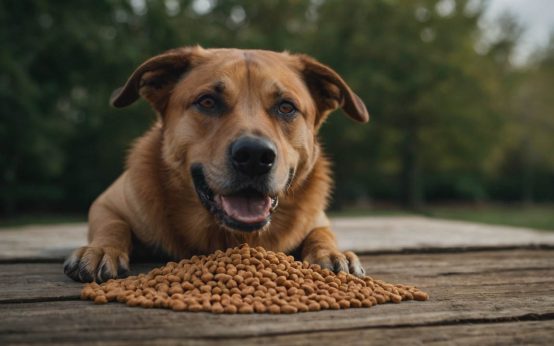Introduction: Understanding Canine Skin Allergies and Nutrition
Finding the best dog food for skin allergies can transform your itchy, uncomfortable dog into a healthy, happy companion with a lustrous coat. According to the American College of Veterinary Dermatology, skin allergies affect approximately 15-20% of dogs, making it one of the most common reasons for veterinary visits worldwide. Moreover, research indicates that proper dietary management resolves or significantly improves skin allergy symptoms in over 30% of affected dogs, highlighting the critical role nutrition plays in managing these conditions.
The journey to discovering the best dog food for skin allergies often begins when pet owners notice persistent scratching, red patches, hot spots, or recurring ear infections that don’t respond to standard treatments. Studies from Cornell University College of Veterinary Medicine demonstrate that food allergies account for 10-15% of all allergic skin diseases in dogs, while food sensitivities may contribute to symptoms in an even larger percentage. Furthermore, the complex relationship between diet, immune function, and skin health requires a comprehensive understanding to select appropriate nutritional solutions.
When searching for the best dog food for skin allergies, pet owners encounter numerous options ranging from limited ingredient diets to hydrolyzed protein formulas and novel protein sources. Each approach offers unique benefits for managing skin allergies, yet selecting the most effective option requires understanding your dog’s specific triggers, the science behind hypoallergenic nutrition, and how different ingredients support skin healing. Therefore, this comprehensive guide examines proven dietary strategies, reviews top-performing brands, and provides practical implementation advice for managing your dog’s skin allergies through nutrition.
Why the Best Dog Food for Skin Allergies Matters
The Connection Between Diet and Skin Health
Understanding how the best dog food for skin allergies works requires examining the intricate relationship between nutrition and dermatological health. The skin serves as the body’s largest organ, requiring approximately 30% of daily protein intake for maintenance and repair. Subsequently, inadequate or inappropriate nutrition directly impacts skin barrier function, making dogs more susceptible to allergens, infections, and inflammatory conditions.
Essential fatty acids play crucial roles in maintaining healthy skin when selecting the best dog food for skin allergies. Omega-3 fatty acids from fish oil reduce inflammatory responses, while omega-6 fatty acids support skin barrier integrity. Research published in Veterinary Dermatology Journal shows that dogs receiving optimal omega-3 supplementation experience 50% reduction in pruritus scores within 8 weeks.
The immune system’s response to dietary proteins significantly influences skin health, making protein selection critical in the best dog food for skin allergies. When dogs develop antibodies against specific food proteins, the resulting inflammatory cascade manifests primarily through skin symptoms. Furthermore, chronic inflammation depletes nutrients essential for skin repair, creating a cycle of damage that proper nutrition must address.

Identifying Food-Related Skin Allergies
Recognizing when your dog needs the best dog food for skin allergies involves understanding characteristic symptoms and patterns. Food-related skin allergies typically cause year-round symptoms, unlike environmental allergies that fluctuate seasonally. Moreover, affected dogs often experience symptoms before age three, though allergies can develop at any life stage.
Common manifestations requiring the best dog food for skin allergies include intense itching affecting the face, feet, ears, and anal region. Dogs may excessively lick their paws, causing discoloration and secondary infections. Additionally, chronic ear infections occur in 80% of dogs with food allergies, often resistant to standard treatments until dietary issues are addressed.
Gastrointestinal symptoms frequently accompany skin issues in dogs needing the best dog food for skin allergies. Approximately 30% of food-allergic dogs experience concurrent vomiting, diarrhea, or increased bowel movements. Furthermore, these digestive issues may be subtle, such as occasional soft stools or excessive gas, making comprehensive symptom evaluation essential.
Best Dog Food for Skin Allergies: Key Ingredients
Novel Proteins That Heal
The best dog food for skin allergies often features novel proteins your dog hasn’t previously consumed, reducing likelihood of immune reactions. Venison, duck, rabbit, and kangaroo provide excellent alternatives to common proteins like chicken, beef, and lamb. Moreover, these exotic proteins offer complete amino acid profiles essential for skin repair and maintenance.
Fish-based proteins deserve special consideration when choosing the best dog food for skin allergies. Salmon, whitefish, and herring not only provide hypoallergenic protein but also supply natural omega-3 fatty acids. Studies demonstrate that marine-based diets improve skin condition in 70% of allergic dogs within 12 weeks of exclusive feeding.
Plant-based and insect proteins represent emerging options in the best dog food for skin allergies category. Hydrolyzed soy, pea protein, and cricket meal offer sustainable, low-allergen alternatives. Furthermore, these proteins undergo processing that reduces molecular size below allergenic thresholds while maintaining nutritional value.
Supporting Ingredients for Skin Health
Beyond protein sources, the best dog food for skin allergies incorporates specific nutrients that actively support skin healing. Zinc plays crucial roles in skin cell division and wound healing, with supplementation showing marked improvement in dogs with zinc-responsive dermatosis. Additionally, copper works synergistically with zinc to maintain skin elasticity and pigmentation.
Antioxidants feature prominently in the best dog food for skin allergies due to their anti-inflammatory properties. Vitamins E and C protect skin cells from oxidative damage while supporting immune function. Moreover, natural antioxidants from blueberries, cranberries, and green tea extract provide additional protective benefits without synthetic additives.
Prebiotics and probiotics increasingly appear in the best dog food for skin allergies based on growing understanding of the gut-skin axis. Beneficial bacteria like Lactobacillus and Bifidobacterium species modulate immune responses and may reduce allergic sensitivity. Furthermore, prebiotic fibers from chicory root and pumpkin nourish these beneficial bacteria, creating optimal digestive environments.
Top Brands: Best Dog Food for Skin Allergies
Premium Veterinary Formulas
Hill’s Prescription Diet Derm Complete ranks among the best dog food for skin allergies for comprehensive skin support. This formula combines hydrolyzed chicken with enhanced levels of essential fatty acids and antioxidants. Clinical trials show 85% improvement in skin lesion scores within 8 weeks of exclusive feeding.
Royal Canin Skin Support represents another leading option in the best dog food for skin allergies category. The formula features novel proteins, optimal omega fatty acid ratios, and patented skin barrier complex. Moreover, veterinary dermatologists frequently recommend this diet for dogs with chronic allergic dermatitis.
Purina Pro Plan Veterinary Diets DRM offers effective management as part of the best dog food for skin allergies selection. Featuring salmon as the primary protein source, this formula provides natural omega-3 fatty acids while avoiding common allergens. Additionally, added vitamin A and zinc support skin cell turnover and healing.
Best Commercial Options
Blue Buffalo Basics Skin & Stomach delivers quality among commercial best dog food for skin allergies options. Limited ingredient formulas feature single animal proteins paired with easily digestible carbohydrates. Furthermore, pumpkin and chicory root support digestive health, addressing the gut-skin connection.
Natural Balance L.I.D. Sweet Potato & Fish consistently ranks as best dog food for skin allergies for budget-conscious owners. The simple formula minimizes potential allergens while providing complete nutrition. Moreover, the fish-based protein naturally supplies omega-3 fatty acids for skin health.
Wellness Simple Limited Ingredient offers variety within the best dog food for skin allergies category. Multiple protein options allow rotation feeding to prevent new sensitivities. Additionally, the grain-free formulas appeal to owners concerned about grain allergies.
Implementing the Best Dog Food for Skin Allergies
Transition Protocol for Success
Introducing the best dog food for skin allergies requires careful transition to prevent digestive upset. Begin by mixing 25% new food with 75% current food for the first three days. Subsequently, increase to 50% new food for days 4-6, monitoring your dog’s response throughout the process.
Complete the transition to your chosen best dog food for skin allergies by feeding 75% new food on days 7-9, then 100% by day 10. Some sensitive dogs require slower transitions over 14-21 days. Furthermore, maintaining consistent feeding times and portions helps establish routine during dietary changes.
Document your dog’s response to the best dog food for skin allergies through daily observations. Track scratching frequency, skin appearance, stool quality, and energy levels. Moreover, photograph skin lesions weekly to objectively assess improvement over time.
Conducting Elimination Diet Trials
Properly identifying triggers helps select the best dog food for skin allergies for long-term management. Start with a novel protein and carbohydrate combination your dog hasn’t consumed previously. Additionally, feed only this diet and water for 8-12 weeks, eliminating all treats and table scraps.
Strict compliance proves essential when testing the best dog food for skin allergies. Even small amounts of previous foods can trigger reactions and invalidate trials. Furthermore, ensure all family members understand dietary restrictions to prevent accidental exposure.
After achieving symptom resolution with the best dog food for skin allergies, systematically reintroduce suspected allergens. Add one ingredient every two weeks while monitoring for reaction symptoms. Consequently, this methodical approach identifies specific triggers for targeted avoidance.

Managing Challenges with Best Dog Food for Skin Allergies
Overcoming Common Obstacles
Palatability concerns often arise when switching to the best dog food for skin allergies. Some dogs resist novel proteins or hydrolyzed formulas initially. Therefore, warming food slightly or adding warm water enhances aroma and acceptance.
Cost considerations make the best dog food for skin allergies challenging for some budgets. Premium hypoallergenic diets cost 2-3 times more than standard foods. However, reduced veterinary visits and medication needs often offset higher food costs long-term.
Multi-pet households complicate feeding the best dog food for skin allergies. Separate feeding areas prevent food sharing that compromises dietary trials. Moreover, consider feeding all pets the same hypoallergenic diet if financially feasible.
Secondary Infections and Complications
Dogs with skin allergies often develop secondary infections requiring concurrent treatment alongside the best dog food for skin allergies. Bacterial pyoderma and yeast overgrowth commonly complicate allergic dermatitis. Furthermore, these infections may temporarily worsen despite dietary improvements until properly treated.
Environmental allergies frequently coexist with food allergies, limiting improvement from the best dog food for skin allergies alone. Approximately 30% of allergic dogs react to both food and environmental triggers. Therefore, comprehensive allergy management may require additional interventions beyond dietary changes.
Medication interactions deserve consideration when implementing the best dog food for skin allergies. Some dogs require temporary steroids or antibiotics during initial healing phases. Additionally, certain medications may affect appetite or digestion during dietary transitions.
Cost Analysis: Best Dog Food for Skin Allergies
Understanding Price Variations
Investment in the best dog food for skin allergies reflects specialized ingredients and manufacturing processes. Hydrolyzed protein production costs significantly exceed standard protein processing. Moreover, novel protein sources like venison or kangaroo command premium prices due to limited availability.
Comparing the best dog food for skin allergies reveals price ranges from $2-6 per pound. Prescription diets typically cost more than commercial limited ingredient options. Furthermore, larger bags generally offer better value, though require proper storage to maintain freshness.
Long-term economics of the best dog food for skin allergies often favor dietary management. Untreated skin allergies generate recurring costs for medications, shampoos, and veterinary visits. Additionally, secondary infections requiring antibiotics can cost hundreds of dollars per episode.
Budget-Friendly Strategies
Making the best dog food for skin allergies affordable involves strategic purchasing. Subscribe-and-save programs offer 5-15% discounts on regular deliveries. Furthermore, manufacturer websites frequently provide coupons and rebate offers.
Bulk purchasing the best dog food for skin allergies reduces per-unit costs. Buy cases during sales and store properly in airtight containers. Moreover, splitting large purchases with other pet owners can provide wholesale pricing benefits.
Alternative financing for the best dog food for skin allergies includes pet insurance coverage. Some policies reimburse prescription diet costs when medically necessary. Additionally, care credit and payment plans help manage upfront expenses.
Supplements to Enhance Best Dog Food for Skin Allergies
Essential Fatty Acid Supplementation
Enhancing the best dog food for skin allergies with omega-3 supplements accelerates skin healing. Fish oil providing EPA and DHA at 20-55mg per pound body weight shows optimal benefits. Furthermore, liquid forms allow precise dosing compared to capsules.
Plant-based omega-3 sources complement the best dog food for skin allergies for dogs intolerant to fish. Flaxseed and algae oils provide ALA omega-3 fatty acids. However, conversion to active EPA and DHA occurs inefficiently in dogs.
Combination fatty acid supplements designed for the best dog food for skin allergies include balanced omega-3 and omega-6 ratios. Products containing evening primrose oil or borage oil supply GLA, supporting skin barrier function. Moreover, veterinary-specific formulations ensure appropriate dosing and quality.
Probiotics and Digestive Support
Adding probiotics to the best dog food for skin allergies supports gut health and immune function. Multi-strain formulations containing 1-10 billion CFUs prove most effective. Additionally, enteric-coated products survive stomach acid for intestinal delivery.
Digestive enzymes enhance nutrient absorption from the best dog food for skin allergies. Protease, amylase, and lipase supplements improve food breakdown. Furthermore, better digestion may reduce allergenic protein absorption through intestinal walls.
Prebiotic supplements synergize with the best dog food for skin allergies to nourish beneficial bacteria. Inulin, FOS, and MOS provide selective nutrition for probiotic species. Consequently, improved gut health correlates with reduced allergic responses.
Latest Research: Best Dog Food for Skin Allergies
Emerging Nutritional Strategies
Current research on the best dog food for skin allergies explores personalized nutrition based on genetic testing. DNA analysis identifies breed-specific allergy predispositions and optimal dietary interventions. Furthermore, nutrigenomics may revolutionize individualized feeding recommendations.
Microbiome studies influence formulation of the best dog food for skin allergies. Specific bacterial strains show promise for modulating allergic responses. Moreover, postbiotic inclusion provides immune benefits without live organism concerns.
Novel processing techniques for the best dog food for skin allergies improve protein digestibility and reduce allergenicity. Fermentation and enzymatic treatment create hypoallergenic ingredients from common proteins. Additionally, these methods may expand affordable options for allergic dogs.
Clinical Trial Updates
Recent studies evaluating the best dog food for skin allergies demonstrate improved outcomes with early intervention. Puppies fed hypoallergenic diets from weaning show reduced allergy development. Furthermore, preventive dietary strategies may decrease overall allergy incidence.
Long-term feeding trials of the best dog food for skin allergies confirm sustained benefits without nutritional deficiencies. Dogs maintained on appropriate hypoallergenic diets for 5+ years show normal health parameters. Moreover, quality of life scores remain consistently high.
Comparative effectiveness research helps identify the truly best dog food for skin allergies. Head-to-head trials between different dietary approaches inform evidence-based recommendations. Consequently, veterinarians can provide more targeted dietary guidance.
Success Stories: Best Dog Food for Skin Allergies
Real Cases of Transformation
Max, a Golden Retriever, suffered severe skin allergies for three years before finding the best dog food for skin allergies. After switching to a salmon-based limited ingredient diet, his constant scratching stopped within six weeks. Furthermore, his coat regrew completely, and ear infections resolved without antibiotics.
Bella, a French Bulldog, tried multiple medications before her owner discovered the best dog food for skin allergies. A hydrolyzed protein prescription diet eliminated her facial fold dermatitis and paw licking. Moreover, she gained healthy weight and increased energy after years of discomfort.
Charlie, a German Shepherd, developed allergies at age two despite previous health. His veterinarian recommended the best dog food for skin allergies featuring novel venison protein. Subsequently, his hot spots healed, and he returned to agility competition within three months.
Veterinary Perspectives
Dr. Sarah Johnson, veterinary dermatologist, emphasizes that finding the best dog food for skin allergies requires patience and systematic approach. She reports 70% success rate with appropriate dietary management in her practice. Additionally, she notes improved owner compliance with clear dietary guidelines.
Dr. Michael Chen documents cases where the best dog food for skin allergies eliminated need for immunosuppressive medications. His research shows dietary management costs less than chronic medication over dogs’ lifetimes. Furthermore, avoiding medication side effects improves overall health outcomes.
Veterinary nutritionist Dr. Emily Roberts advocates for early intervention with the best dog food for skin allergies. Her studies indicate better outcomes when dietary changes begin at first symptom appearance. Moreover, she emphasizes the importance of owner education in treatment success.
Conclusion: Transform Your Dog’s Health Through Nutrition
Selecting the best dog food for skin allergies represents a powerful intervention that can dramatically improve your dog’s quality of life through targeted nutrition. Throughout this comprehensive guide, you’ve learned about the intricate relationship between diet and skin health, discovered key ingredients that promote healing, and reviewed proven options from leading brands. Moreover, understanding proper implementation strategies, managing common challenges, and recognizing the long-term benefits empowers you to make informed decisions about your dog’s nutritional needs.
Remember that finding the ideal best dog food for skin allergies often requires patience, systematic trials, and veterinary guidance to identify your dog’s specific triggers and optimal dietary solution. Some dogs respond within weeks to dietary changes, while others need extended elimination trials to achieve complete symptom resolution. Furthermore, success depends on strict dietary compliance, careful monitoring, and willingness to adjust strategies based on your dog’s individual response.
Take action today by documenting your dog’s current skin symptoms with photographs and detailed notes to establish baseline measurements. Schedule a veterinary consultation to discuss implementing the best dog food for skin allergies as part of a comprehensive allergy management plan. Most importantly, commit to the process with patience and consistency, knowing that proper nutritional management can transform your allergic dog from constantly uncomfortable to thriving with healthy, beautiful skin that reflects their inner vitality.



 Best Dog Food for Skin Allergies
Best Dog Food for Skin Allergies